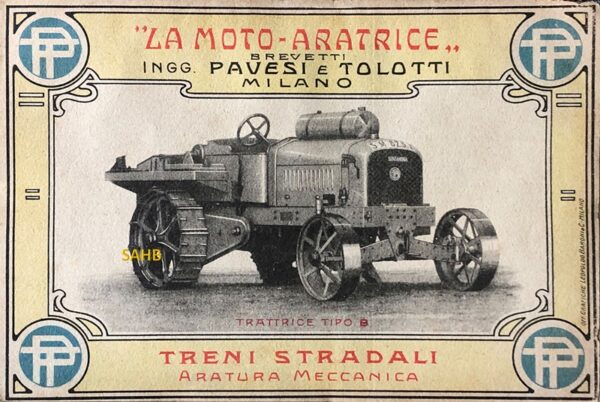
This solid and seemingly unremarkable tractor was the creation of two brilliant and fascinating engineers. Ugo Pavesi was born in Novara, a city just west of Milan, June 1886 and grew up in relatively comfortable and cultured surroundings. Having developed a passion for all things mechanical, Pavesi enrolled in an engineering course with a specialisation in mechanics at the Regio Politecnico di Torino. He graduated in 1909.
Pavesi’s first job was unsurprisingly at the local firm, FIAT, but he soon got itchy feet and moved on; at only 23 years of age, he already had projects he wanted to realise, and decided that he needed to start his own firm.
Pavesi contacted various financial institutions but failed to convince any of them to back such a young and inexperienced engineer. It was clear to him that he needed to find an older partner who would have the credibility to convince bankers to support his ideas. He found such a man: the engineer Giulio Tolotti. A bank agreed to back the two of them, and La Moto-Aratrice Brevetti Ingegneri Pavesi & Tolotti Società Anónima was created in 1910. Pavesi reserved for himself the positions of general manager and designer. Giulio Pavesi was technical director. ‘Moto-Aratrice’ translates as ‘motor plough’ – so it was clear from the start that the two men were specialising in agricultural vehicles.
The company’s prospects were greatly enhanced by the outbreak of World War I; the Italian army had a sudden need for all types of vehicles – especially those that could haul material over badly broken ground. The Pavesi & Tolotti tractor was not only effective in this role but could also haul trailers over rough ground. In total, the company received orders from the army for 1,000 tractors and 5,000 trailers. Our Snapshot shows an advertisement from a 1917 magazine; the words ‘Treni Stradali’ translate as ‘Road Trains’.
The tractor weighed nearly 5 tonnes and was fitted with a 4-cylinder petrol engine producing 50bhp at 800rpm. Despite the small size of the engine, it could haul up to five 20-tonne wagons hitched together up to a total weight of 100 tons at up to 3 miles per hour. This hauling ability made it an ideal basis for conversion into an armoured vehicle, and one prototype was for an ‘Autocarro Tagliafili’, an armoured wire-cutting vehicle.
After the war Pavesi designed an revolutionary agricultural tractor. The P4 tractor had four large wheels, all steered and powered, with articulation in the middle. This four-wheel-drive tractor was one of the first in the world and created a sensation. But during this period of political instability the design went nowhere, and Tolotti sold his shares in frustration in 1921. The P4 was eventually produced and, although almost twice the price of a conventional tractor, was made until 1942.
Image courtesy of The Richard Roberts Archive: www.richardrobertsarchive.org.uk







Leave a Comment